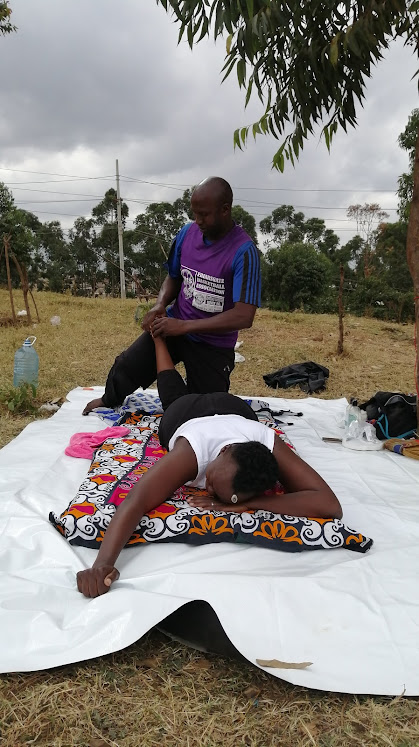
The first time I went to see Kimaiyo I wailed like a baby. I had been running for over a year. Not once had it occurred to me that I needed to see a physiotherapist. That was until my heel and ankle were in such agonizing pain, I couldn’t run anymore. Even walking was proving hard. So I did what every recreational runner does, I reached out to a fellow runner. “You need to go see Kimaiyo” they advised. I called and booked a session. He does this like the battle-hardened elder he is, under a tree in the Langata barracks.
It was there, outside in the open under a eucalyptus tree that I lay on a mat and cried openly with no shame like a child as men played football. Every part of my body had accumulated what I would later learn with trepidation is called lactic acid. Every runner’s nightmare.
If you are yet to encounter it, lactic acid will have you grabbing onto a mattress, teeth sunk on some pillow as some d fascinated children mill around asking “Mbona analia?”.And Kimaiyo with an evil smile tells you “pole”. Hey says“anaskia uchungu, sasa ondokeni hapa ” explaining the pain am feeling as he shooes them away,
The excruciating pain that his hands call out while he kneads and twists and sinks his elbows on your limbs is an experience that any runner elite or recreational eventually surrenders to.
You see it in their eyes. You hear their shrill sounds like a bull being put down. That eucalyptus tree and the four walls in the various physio clinics along Ngong Road and at the Warwick Center know the tales of wailing, pleading and cursing runners.
So what is physiotherapy and why would anyone want to take themselves through such excruciating time and again?
It’s a question I, just like any other runner who has muscles have been at the mercy of those kneading arms keep asking myself every time I find myself on that mat. So I went to Joseph Wainaina, a renowned physiotherapist registered and licensed by the Physiotherapy Council of Kenya.
Wainaina who is working at the Nakuru County Government, stationed at Nakuru PGH, has previously AIC Kijabe Hospital the orthopaedic, Sports Injury and Post operation Rehabilitation Department. He holds an advanced certificate in assessment and management of elite athletes and evidence-based assessment and management of low back pain.
How different is physiotherapy from massage?
First of all, physiotherapy is a part of medicine that deals with treatment through physical means, exercises and electoral physical agents to sports injuries and other medical cases, while massage is used for medical purposes only in physiotherapy like sports massage to treat athletes. However, Massage itself is also a non-medical practice that people do for fun or relaxation purposes.
How does physiotherapy help runners?
In running, injury is something at some point one can’t avoid despite how physically fit one may be and that’s where Physiotherapists come in. By giving education and means of preventing injuries, offering treatment and doing a follow-up on prognosis and how to prevent the recurrence of injuries.
What happens during a typical physiotherapy session and what to expect
In a typical session for instance first time, a physiotherapist takes a clinical history on the need of a runner visiting a physio centre and if it’s because of an injury; how it occurred, followed by a thorough medical assessment that includes a physical exam and then analyzing the findings and coming up with could be affected and how to go about treating the injury.
Normally in physiotherapy treatment expect gait analysis, exercises (stretches and
strengthening), sport soft and deep tissue mobilization (massage), orthopaedic manipulations and sometimes electrophysical machines applied to you for treatment purposes.
When should you go to a physio and why is prevention better than a cure
As regular as possible, but also depends on the advice from your physiotherapist.
This is because one can prevent the injuries from coming, worsening from mild to worse and avoid surgeries also you’ll avoid retiring early from sports or shifting to a different kind of sport.
What are the common causes of injuries?
They are many and not limited to;
- Failure to adhere to or incorrect form of warmups and cooldowns
- Insufficient information on principles of sports which includes individuality, specificity
- progression, overload, adaptation, recovery and reversibility
- Incorrect sports wears
- Combining various sports like gym and running
- Poor nutrition
- Self-treatment from Dr. Google. One ends up causing more harm than treating
What are common injuries in runners?
- Muscle pulls and spasms due to fatigue
- Sprains and strains
- Tendinopathies and tendinosis
- Back pains and nerve irritations
What are some common misconceptions that runners have about physio and injuries?
- The most obvious one- that physiotherapy is massage.
- Physio is painful, though you might doubt it since at some point you have experienced pain during a physio session.
- That one does not need physio and after a few days of rest and painkillers, the injury will be over and be back to normal running.
- Running through the pain believing that you will get used to it and adapt
- You do not need to stretch
- Last but not least, changing running shoes and thinking that the only thing you need to do and you will be okay